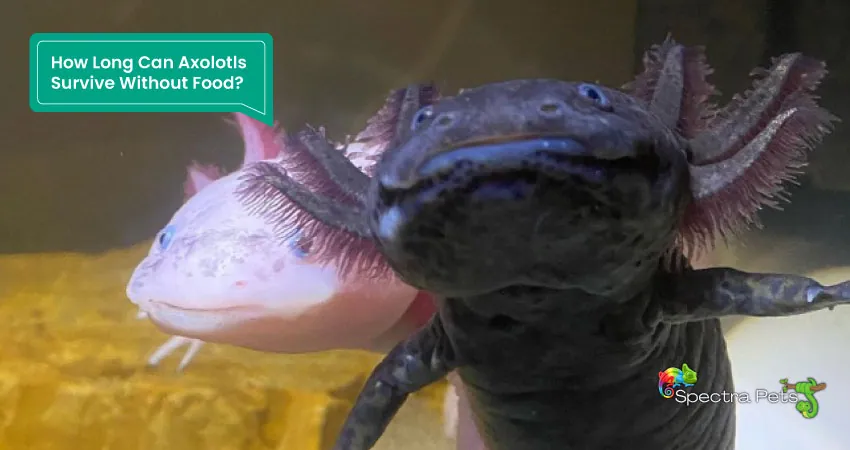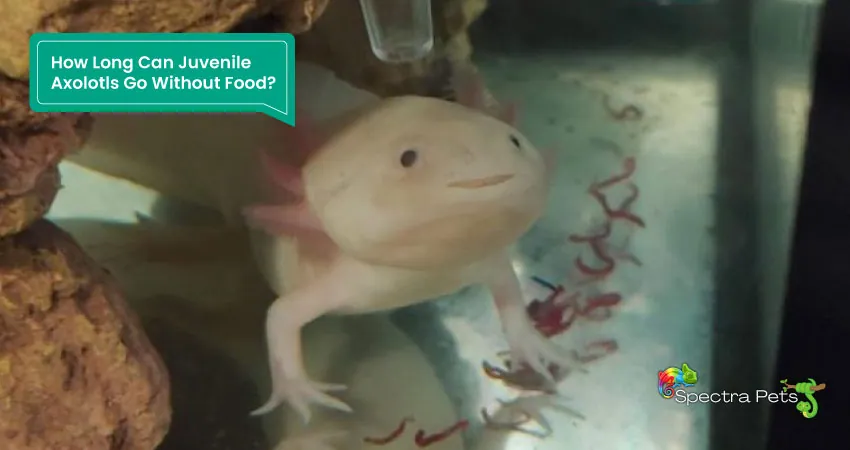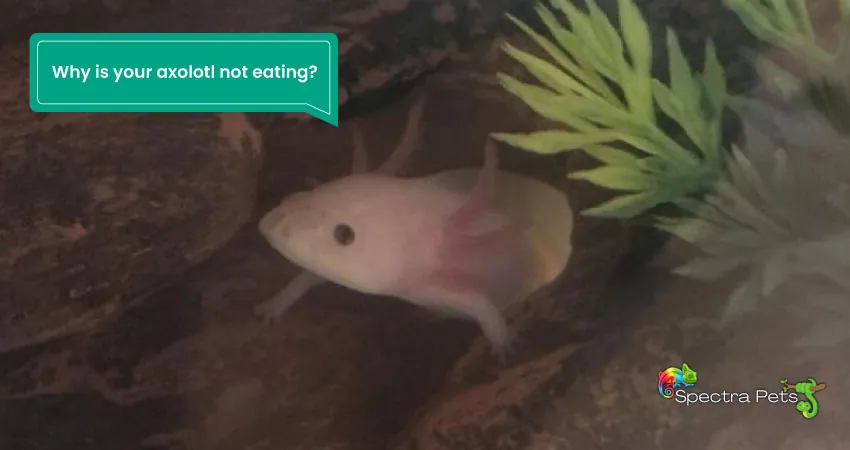As an axolotl owner, taking care of your pet requires a significant amount of effort. If you’ve noticed your axolotl going without food for an extended period, it can be a concerning experience, especially for those new to pet ownership.
Adult axolotls can live without food for about 3 weeks. Young axolotls can live for up to 5 days without food. Baby axolotls can live for 3–5 days without food.
There can be a variety of reasons for food refusal in these fascinating creatures. In this article, we will explore the duration that axolotls can go without food and identify the factors that may cause food refusal. Let’s dive into it!
How Long Can Axolotls Survive Without Food?
Survival without food in the case of an axolotl can vary from one to another. A fully functional & active axolotl can easily survive for around 3 weeks smoothly. In lucky cases, your lovely friends can go up to 4 weeks. However, if they had some sort of underlying illness then it won’t survive more than 2 weeks.

It would be a wrong move to see the result of an axolotl without giving it food for a long time. It’s crucial to follow the regular feeding time to keep the species in good health.
Any kind of overfeeding or low feeding will create a high burden on their health. So, you need to maintain a properly balanced diet for them.
How Long Can Baby Axolotls Go Without Food?
If you are the owner of baby axolotls then you have to be extremely careful because they need food every day.
A baby axolotl can go only 3–5 days without any food. And soon after that, it will collapse.

How Long Can Juvenile Axolotls Go Without Food?
A juvenile or young axolotl will require more food due to their high growth phase. In this stage, they can only survive up to 5 days without any food.
So try to handle them with more care at this specific stage of their life.

How Long Can Adult Axolotls Go Without Eating?
Whenever Axolotl reaches adulthood they require at least 2-3 times eating per week. Anything less than that would prevent their normal function & growth. A significant number of adult axolotls will survive 2 weeks without any health problems.
However, some weak Axolotls might start showing signs of weakness right after crossing one & half weeks without any food.
As I mentioned earlier, some tough boys can survive up to 4 weeks. But the average adult would go 2 weeks swiftly.

Related Article: What Do Axolotls Eat in the Wild?
What Happens If Axolotls Go For Too Long Without Food?
Just like any other species, when the axolotl reaches the maximum level of starvation, the body will fail to function properly due to lack of nutrition.
So the Axolotl will be dead if it’s not eaten for around 2+ weeks.
Why is your axolotl not eating?
If you want to find out why your axolotl starts a full block on food consumption then the reasons are many.
In the following, I will describe them in detail:
1. Impaction
Whenever you see axolotl not taking any food for a few days continuously then there’s a high chance that they consumed something which makes a blockage.
Oftentimes this can happen as they are prone to eat the gravel and small rocks in their water tank.
2. Intestinal parasites
Parasites are always waiting to attack your cute axolotl. Most of the time it’s the intestinal parasites that cause the trouble which makes it very hard for the axolotl to consume food.
If this happens, they can stop eating for a week or more than that. The assistance of a veterinarian will be extremely helpful for the little buddy.
3. Bad quality & too large size food
The quality of the food has a huge impact on the food consumption of your pet Axolotl. Low-quality food like improperly preserved food & damp or outdated pellets will make you upset. As a result, Axolotl may stop eating at all.
Every time you change the size of the food as they grow up, you might provide them with a bigger chunk of food. Slowly increase the size of the foo, orr they will find it hard to eat the food.
Regarding quality, you need to ensure they don’t remain hard after dropping into the water. If it doesn’t become soft, the pet would find it tough to swallow. Sometimes pellets that get too much exposure to air lead to bad taste, so the axolotl may stop eating that food.
Planning to feed them preserved worms might backfire because of the bitter taste.
4. Stress
Like any other animal, the Axolotl also faces stress. And as soon as any stress factor starts to build up quickly, they slowly reduce their food intake.
Factors like bad water quality & wrong tank mates can affect them badly. So, always keep a close look at the water quality of the Axolotl tank. Check if they are having any attacks from their tank partner like fish.
You can easily spot a stressed-out Axolotl by two strong signals. One is they will start swimming faster inside the tank & keep doing that for hours. The second one is they will hide under the shelters for a long time.
Help them to relieve stress, and they will come back to their normal eating behavior.
5. Bloating belly
Anytime you notice the Axolotl having a bloated belly, most probably it won’t be able to eat food. Due to the bloating, the digestive tract gets pressured from the outer side, making it hard for them to digest any food.
One of the main reasons for bloating is the eggs of the Axolotl. When females have a lot of eggs inside their bellies, they simply can’t eat and here you need to help your aquarium queen.
Get a male axolotl inside the tank so that he fertilizes the egg so that she can lay the eggs. Add plants for egg laying. Right after she is done with laying the eggs she will be able to eat anything just like before.
6. Poor water quality
It’s normal for an axolotl to stop eating when the water quality degrades too much. Usually, it happens due to the malfunctioning of filtering which leads to an increase of ammonia inside the tank.
As soon as the ammonia level goes high, your gorgeous pet will have health problems. You have to keep the ammonia level to 0 ppm.
Another culprit is the altered nitrite level. If it goes more than 60 or falls less than 20 ppm the axolotl will feel uncomfortable and refuse to eat anything.
7. Noisy & high power filter
Though it may sound lucrative to install a powerful filter that generates noise inside the tank, in reality, it’s unnecessary for an axolotl tank.
A strong filter will produce waves in your axolotl aquarium which makes it hard for them to roam around swiftly. They like to move around in calm water because it does not give them any opposite force during movement.
Most of the powerful filters will create a loud noise that would put your axolotl under heavy stress.
Due to both the excessive sound & waves in the aquarium they can stop consuming any food.
8. Sickness
Sickness is a strong reason for the axolotl to avoid food. It can be any underlying conditions or even outer wounds.
Sometimes axolotl gets hurt by the bite of mealworms when they try to eat them. Also, they can have wounds on their skin or gills due to abrasion from the gravel and stones inside the aquarium.
9. Overfeeding
When no disease is found plus the tank water is in top-notch condition and the Axolotl is not eating, that means you are overfeeding your pet.
Usually, an every-other-day meal would be enough for an adult Axolotl though the juvenile one may eat more. However, you can make your axolotl to do fasting & provide them fresh food after 3 days. Hopefully, they will start eating instantly.
10. Wrong water temperature
Every species has its favorable temperature which they find most comfortable to live in. For Axolotl, the right temperature is 16-18 degree Celsius. Anything more or lower than that would create stress on their health.
If in summer the water temperature of the axolotl aquarium stays more than 22-degree Celsius for a long time then it would affect the pet badly. As a result, they will put a red light on eating any food.
Comparatively, warmer water would make the breathing process hard for the Axolotl, which will force it to enter a survival mood. So they will frequently go to the surface water to take a breath. Because the breathing process gets harder, the axolotl will eventually stop eating food.
11. New tank
Every time you introduce an axolotl to a completely new setup it will take a bit of time to settle. Which may cause them to refuse the food for a few days, but that’s not a big issue at all.
As soon as they get adapted to the inner climate of the new aquarium and when they are done with the primary exploration journey of the aquarium, they will come back to their normal feeding mood. So give them4–55 days to adjust and don’t need to hurry & worry at all.
12. Aggressive tank partner
If there’s too much size difference between two axolotls or if the fish inside the tank is a bit aggressive, your axolotl will have a tough time eating.
Because it will be attacked for sure which can cause physical damage like cutting on gills, and wounds on limbs and skins. So they will hide under shelter and stop eating at all.
Read More:
13. Pre-Hibernation mood
With the appearance of winter, the aquarium water temperature will fall and if you keep it like that then your axolotl will turn on its pre-hibernation mood. They will slow down their metabolism and will consume at least ½ of what they eat regularly.
So when the temperature stays low below 16-degree Celsius for a few days it will surely reduce their food consumption. In case of a sudden fall in temperature, this process will occur faster.
To prevent them from losing their appetite, you should use a heater to maintain the tank temperature between 16–18 degrees for normal feeding behavior.

Can you force-feed an axolotl?
Let me tell you straight that force-feeding is not a recommended way of feeding the axolotl. But sometimes they starve so much that they literally take themselves close to death, and then you have to get in action.
The process is not opening their mouth & stuffing pellets or meat pieces. Rather you will use a syringe to push the wet and liquid pellets inside their mouth.
Please remember you can’t do this to young and baby axolotl. This feeding is only applicable for adult axolotl.
Final words
I know you had that tense feeling when you realize your beautiful axolotl is skipping food for a long duration.
Hopefully, after going through this short post you have a piece of minimum knowledge on why they do that kind of behavior and what’s the last time range they can survive up to.
I expect you can now easily deal with your hungry & lethargic axolotl that was going without food for a long time.

